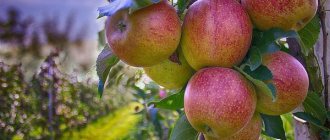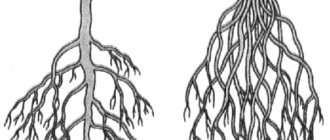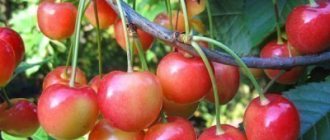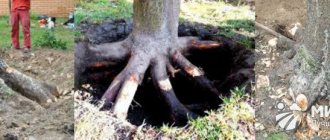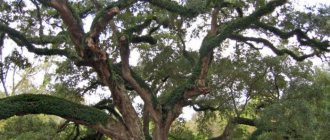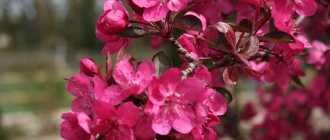When planning a garden, there are many things to consider, including the lifespan of plants. The longest-lived fruit crops are pome trees - apples and pears, which can grow and produce a good harvest for decades. But their maximum age is also not the same and depends on a number of factors.
Most apple varieties provide high productivity over a long period
A little history
The apple tree is the most ancient garden tree of all existing on Earth. Mention of this plant is found in biblical stories. Researchers say that the first apple trees appeared several thousand years ago. Archaeologists were able to discover charred appendages at the excavation sites. The fact that apples were popular even before our era is also evidenced by images on the monuments of Ancient Egypt. According to scientists, wild varieties of apple trees first appeared in Asia, North America, China and Central Asia. The Greeks introduced them to Europe sometime in the second millennium BC. Since then, fruits have become an integral attribute of European cuisine.
Apples appeared in Rus' during the reign of Yaroslav the Wise, however, they became most widespread a little later, under Yuri Dolgoruky. It was during his reign that the regulation on the distribution of fruit trees began. How many years does an apple tree live in the Moscow region? It is believed that the most popular varieties of this plant live about 80-100 years. After this time, the apple tree becomes less prolific and slowly fades away.
Much can be said about the benefits of apples. This fruit is rich in vitamins and iron, so it must be added to your daily diet.
How old is the apple tree and where does it live?
As we have already said, the lifespan of apple trees varies, but on average it is 50 years. Let's take a closer look at the reasons that determine this figure.
Terrain . First of all, health, fruiting and life expectancy depend on the area in which you plant the trees. In the south of our country, where winters are mild and warm, apple trees live for 100 years, since they do not have to deal with strong temperature changes and resist winter frosts. But already in the middle zone, an apple tree lives only 60 years, provided that the tree is well cared for.
In the northern regions, in Siberia, in the Urals, it is advisable to plant only frost-resistant varieties, carefully care for them and wrap them up for the winter, but even if all the rules are followed, the maximum life expectancy will be about 40 years. Compared to a hundred years in the southern regions, this may seem like a small amount, but in fact, given the difficult climatic conditions, this is a very good indicator.
There is also such a thing as life form , this also affects the lifespan of a tree. On this basis, all varieties can be divided into two types: early-bearing and late-harvesting. And we are not talking about the timing of apple ripening, but about the time after which the tree first begins to bear fruit. It has been scientifically proven that a tree that begins to bear fruit later lives longer. For example, columnar apple trees may begin to bear fruit in the second or third year, but after 15 years the tree will most likely end its life cycle. At the same time, the life of an apple tree, which is grown from seeds, is incomparably longer, since they begin to bear fruit no earlier than in the tenth year (and sometimes in the fifteenth). These factors must also be taken into account when choosing seedlings for your garden.
Well, last but not least – tree care . If you do not pay attention to the garden, then even the most tenacious variety in the most favorable area can be ruined. Therefore, carry out all necessary measures in a timely manner, including pruning, preventive treatment against diseases and harmful insects, fertilizing and preparing trees for winter.
Region of growth
How many years does an apple tree live in Russia? This primarily depends on the region. For example, in the southern regions this figure is significantly higher than in the northern ones. Here you can find long-lived trees, whose age is approximately 150 years. Plants in mid-latitudes are characterized by a shorter lifespan. Most apple trees here live up to 100 years. In the northern regions, trees older than 50 years are very rare. The average age of the plant, typical for this climate zone, is 30-35 years.
Features of life cycles
Apple trees grow and bear fruit for many years
Every tree, incl. And in the common apple tree, there are several periods in life:
- the first 5-15 years, depending on the variety;
- period from 15 to 40 years;
- the third cycle is characterized by the gradual dying of the tree. Individual for each type.
First
This life cycle of a garden apple tree covers the first years, when the root system of the seedling becomes stronger in the soil and it begins to bear fruit. This is an important time in the development of every tree. During these years, all the branches that will produce apples are laid. The root system is strengthened, so the tree can withstand bad weather in the future.
At this time, it is worthwhile to form the crown of a young tree, because the first period is characterized by the rapid growth of skeletal branches. This can increase not only the yield, but also the average lifespan of the apple tree.
Second
At this time, the growth process slows down. On average, this cycle lasts about 20-25 years. During this period, you need to monitor the apple tree with great care: it may develop problems with its branches. If you do not trim improperly growing shoots in time, you can end up with a tree with a dense crown, the branches of which will be tightly intertwined with each other.
Such an apple tree will not be able to produce fruit as before. If you stop monitoring it, you can achieve a complete cessation of fruiting. Due to high humidity, moss and lichen begin to grow on the branches. But, if you start pruning the shoots again, there will be a chance that the tree will delight you with fruits for several more years.
Third
In the third period of apple tree development, all life processes slow down and stop. At this time, the branches begin to dry out, the fruits no longer form, and flowering does not occur in the spring.
If apples are sold, then such a tree will reduce profits: it takes up a lot of space, but does not pay for it at all. Therefore, apple trees that have lived for more than 50 years must be uprooted.
Second period
With the onset of 15 years of age, the second stage of the plant’s life begins. At this time, the apple tree produces a rich harvest. The growth rate is gradually starting to decline. However, it is worth considering that these indicators are very conditional and depend on many factors. If you do not care for the plant properly, it may simply die. The tree will not benefit from strong interweaving of side branches and thickening of the crown. Under such conditions, good fruiting is unlikely to occur. The apples will most likely be small and not juicy.
These fruit trees are very susceptible to deformation. Moss and lichens may settle in places where branches are broken. In the vicinity of such trees, the growth of a large number of shoots is usually observed. In this case, inexperienced gardeners may conclude that the apple tree has gone wild or is degenerating. However, a way out of this situation can be found. It’s enough just to start caring for the tree and remove all unnecessary parts, and some time later you can easily reap a rich harvest.
What determines the longevity of an apple tree?
The average lifespan of an apple tree is 60-70 years, and some trees can actively bear fruit for longer. The lifespan largely depends on which rootstock the selected variety is grafted onto. The following types of rootstocks are commonly used in gardening:
- vigorous (seed);
- semi-dwarf;
- dwarf.
Plants for which vigorous (seed) rootstocks are used as a rootstock have the longest period of productivity. Such trees have a powerful tap root system that goes deep into the soil, grow tall, have a spreading crown and are characterized by abundant fruiting. When planting them, it is important to choose areas where the depth of groundwater is at least 3 meters.
Trees on seed rootstocks are large and require a lot of space
Apple trees on a semi-dwarf rootstock are shorter and have a less deep root system. Typically, they live between 30 and 40 years. The trees grow up to 5 m in height, and due to the fact that the roots are too long, they can be planted where groundwater reaches a level of 2.5 m from the surface of the earth.
Varieties grafted onto a dwarf rootstock, or natural dwarfs, have the shortest lifespan, which ranges from 15 to 20 years. The height of plants usually reaches 2-2.5 m, and the superficial root system allows them to be cultivated in places with high groundwater levels (up to 1.5 m).
Low-growing trees allow compact planting in commercial gardens and small summer cottages
Columnar varieties of the crop, in which the period of active fruiting is no more than 15 years, deserve special mention. When productivity indicators decrease, they are uprooted and replaced with new ones.
Let's summarize the data in the table:
| Type of rootstock | Average life expectancy, years | Tree height, m |
| Vigorous, seed-bearing | 50-70 or more | 7-8 |
| Semi-dwarf | 30-40 | 4-5 |
| Dwarf | 15-20 | 2-2,5 |
Every time, when choosing seedlings, gardeners pay attention to the variety, but sometimes they forget to ask what rootstock it was grown on. However, this is an equally important factor, since it has a significant impact on tree growth, yield, life expectancy, frost resistance, and disease resistance.
A high-quality rootstock well adapted to local conditions can be obtained from seeds or clones (cuttings and layering) of varietal and wild varieties of the crop.
To independently propagate a selected variety using grafting, experienced gardeners use seedlings of some cultivated varieties as rootstocks, for example, “Antonovka”, “Borovinki”, “Grushovka”, “Cinnamon Striped”, wild apple trees and other plants also included in the Rosaceae family .
Here is brief information about some vegetatively propagated commercial rootstocks, common in the central zone, as well as other regions of Russia:
| Rootstock name | View | Characteristic |
| M8 | Dwarf | The height of trees grafted onto this rootstock is no more than 2 m, life expectancy is 20-25 years, fruiting begins in the third year, productivity may decrease with age. The root system is shallow (up to 60 cm), for this reason the plants are not very stable. It is not usually used in industrial gardens; it is suitable for growing in personal plots, where the tree can be provided with sufficient watering and protection from the winds. Gardeners note that summer apple varieties begin to ripen on such a rootstock 10-15 days earlier |
| M9 | Dwarf | One of the most common dwarf rootstocks. The height of trees grafted on M9 reaches 2.5-3 m. The lifespan of an apple tree is approximately 25-30 years. Fruiting begins in the 3-4th year; in old trees the yield decreases; in industrial orchards they are replaced before reaching their maximum age. The root system is superficial, reaches a depth of 70 cm, so the plants are not very stable and need support. Frost resistance is rated as average |
| M7 | Semi-dwarf | Apple trees can grow up to 3-3.5 m in height; after fruiting, the growth vigor decreases. They begin to produce crops approximately in the 3rd year after planting. The root system is branched and more powerful than that of the M9 and M8 rootstocks. Frost resistance is average. Characterized by good compatibility with many zoned varieties |
| 54-118 | Semi-dwarf | A widely known winter-hardy rootstock of Russian selection. Used for growing medium-sized apple trees. Fruiting begins in the 4-5th year. Trees on this rootstock in the first years of life produce greater yields than those grown on other medium-sized and vigorous rootstocks. The root system is powerful, branched and firmly holds the tree. Suitable for cultivation in unfavorable climatic conditions, combines well with varieties zoned for central and northern regions |
| A2 | Vigorous | It is used to produce vigorous, early-fruiting trees, since flower buds usually appear on last year's shoots. The root system is strong, branched, has many skeletal roots that go deep into the soil vertically, which contributes to better absorption of moisture. They are characterized by high frost resistance, and with partial freezing they quickly recover |
Many domestic and foreign nurseries are engaged in the production of planting material (in the photo - dwarf rootstock M9)
How to rejuvenate an apple orchard?
How many years does an apple tree live? When does it stop producing crops? Many gardeners ask these questions. Over time, the time comes to get rid of old trees.
To do this, use the following algorithm of actions:
- A trench is dug around the trunk of the apple tree. Its depth should be such that you can easily cut off the root shoots.
- To fell one medium-sized tree, the efforts of 2-4 people will be required.
- When the apple tree is felled, it is necessary to remove large root parts, and then cut and dispose of the trunk.
During the process of decay, shoots may appear in large numbers on the tree. A year later, the stump will collapse on its own. After this, you can easily remove it from your garden plot. To preserve the apple orchard, a young tree is planted in place of each tree removed. In this case, you will be guaranteed a harvest of beautiful fruits for many years.
How to increase the fruiting period and productivity of apple trees
For gardeners, it is important that the tree does not grow easily on the site for a long time, but it also provides benefits in the form of an annual harvest. Even fruiting once every two years suits summer residents. In many ways, the period measured by nature depends on the variety, and secondly, on the conditions.
The first fruits appear on the apple tree at 3-5 years. Every year the yield increases. In reality, a tree exhausts its resource in 20-40 years. On my site this is primarily due to improper pruning of the tree. Therefore, I will pay special attention to this common mistake of gardeners.
But before giving advice, I advise you to watch the video. Visual recommendations will help you get an apple harvest every year:
Removing old trees from the garden
If it's time to remove the tree, there are various options. You can uproot the tree, get rid of it using chemicals, or use a folk remedy - saline solution.
The mechanical method can be called the most labor-intensive; it will require the presence of several physically strong people and some time. There is no need to saw or chop the tree; step back a meter from the trunk and dig a ditch; the main goal of this process is to get to the roots of the apple tree and chop them with an ax. Then several people begin to swing the tree and do so until it collapses. After the tree falls, it is necessary to remove the remaining roots from the ground, and only then start cutting the tree crown and cleaning the area. But when it is not possible to attract help, then most likely one of the following methods will suit you.
Chemical method . Such work will require less labor, but more time; the process of destroying the stump and roots can take two years.
First, you need to cut down the tree and drill four (or more) holes about 15 centimeters deep in the stump. The more holes there are, the faster the process will go. We will not uproot the stump, but will make some efforts to start the decomposition process in it. To do this, you need to pour nitrogen fertilizers into the holes made and replenish their supply every couple of weeks.
When and how to uproot old trees
Usually, only hopelessly decrepit or terminally diseased trees are uprooted. After the verdict has been passed, the most convenient method of uprooting is chosen: this can be uprooting the whole tree without cutting down the trunk or uprooting the stump remaining after cutting down.
Mechanical uprooting of trees
This method is used when it is possible to use heavy equipment or brute physical force.
- A trench is dug around the tree at a distance of 80-100 centimeters from the trunk. The depth of the trench should be sufficient to allow access to large roots.
- All large roots are cut off with an ax.
- With the help of several people, the tree is rocked until it topples over. If it is possible to use special equipment, then the trunk is tied with a cable, the other end is tied to a tractor and, simply pulling the cable, the tree is felled.
- All branches are cut off, the trunk is sawn, and the cut roots are pulled out of the ground.
Chemical stump removal method
This method is most often used after cutting down the trunk, provided that the tree has been infected with any pathogens of fruit crops. They also resort to it in order to prevent the growth of growth from old roots.
- The remaining stump is drilled with a drill in several places, trying to drill as many holes as possible with a depth of at least 15 centimeters.
- Any nitrogen fertilizer, for example, urea or ammonium nitrate, is poured into the resulting drilled holes.
- Throughout the summer, fertilizers are regularly added, and the roots are dug up a little to speed up the process.
- In the first year, a lot of young growth may appear around the stump. There is no point in starting a fight against it, since next year it itself will die along with its roots.
- When using urea in the second year, complete decomposition of the root system will occur, and the stump can be easily dug out with a shovel.
- When using saltpeter, stumps and roots soaked in the chemical are simply burned out. Burning is also carried out in the second year after placing fertilizer in the holes.
How to speed up the fruiting process
You can speed up the process of fruit appearance with simple manipulations. There are 2 ways in which the process of harvest formation is approached without damage to the tree: chemical and physical. The first involves treating garden crops with fertilizers or solutions that accelerate the appearance of the crop. And the second includes a series of actions that are designed to “outwit” nature.
Bending down branches
Bending down the branches of an apple tree is an absolutely safe way to speed up its growing season. The essence of the method is to increase the angle of their inclination, and thus growth will accelerate, which in turn will contribute to the rapid appearance of fruits. The process looks like this:
- In the spring, several thin branches are selected that are strong enough not to break, but also flexible to yield to the applied force.
- A strong spacer is installed between the trunk and the branch, which will bend it in the direction opposite to the trunk.
- A strong rope is tied to the branch, the other end of which is wrapped around the trunk closer to the ground.
- In summer, the spacer and rope are removed.
This method is only suitable for relatively young trees, since old ones cannot be bent without damaging the apple tree.
Pinching
Another great way to speed up the start of fruiting. But it is only suitable for young trees with weak wood. It is carried out as follows: when the seedlings reach a height of 25 cm, you should pinch the tops of the shoots so that about 3 leaves remain from the trunk. Because of this, the apple tree will have to spend a lot of effort on ripening the branches, due to which the fruiting process itself will accelerate.
This method is easy to implement, but its effect will become noticeable only 2 years after planting the apple tree.
Banding
This method of accelerating the process of fruit appearance is suitable for both young and adult garden crops. The essence of the method is to select several large and strong branches, wrap strong wire around their base and twist it using the rope technology. To avoid damage to the bark, it is necessary to place soft cloth or rubber under the wire. The puff is left for 2 months and then removed.
The rate of fruiting of the tree will increase several times, and the first abundant harvest will be obtained within a year.
Previous
Harvest
